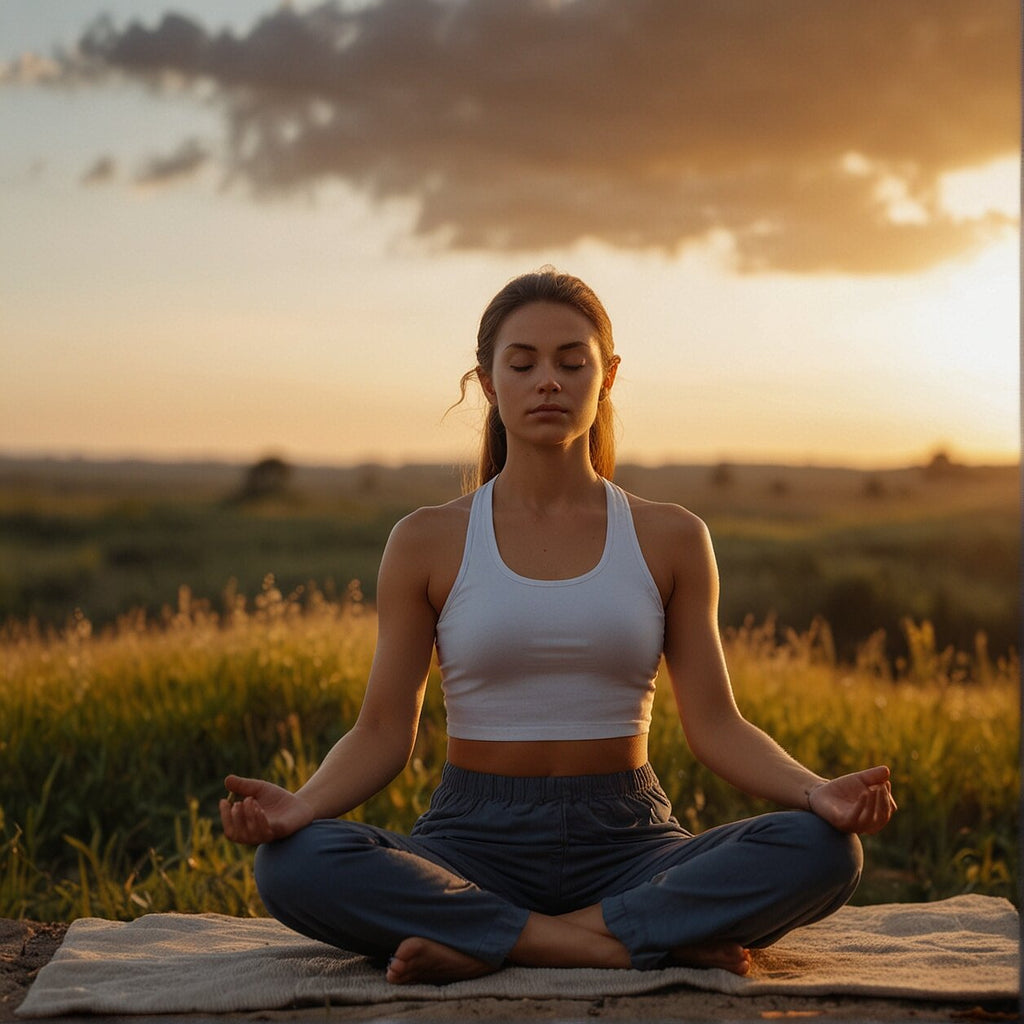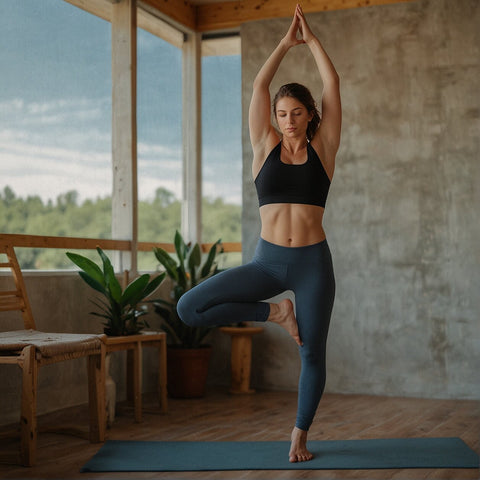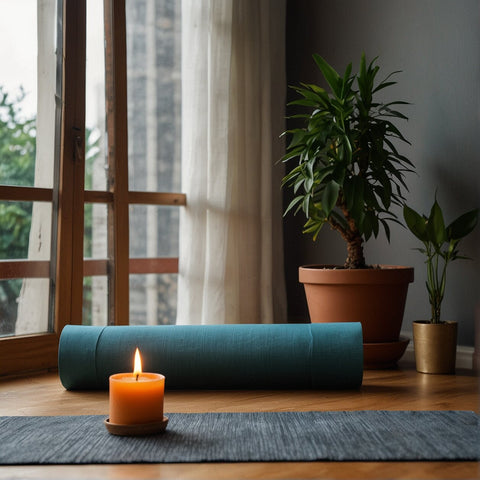
Have you ever wondered how to uncover a deeper level of truth about yourself and foster personal growth? If so, you might be surprised to learn that the key lies in combining two powerfully transformative practices: yoga and mindfulness.
Through the fusion of these practices, you can embark on a fulfilling journey of self-exploration and growth. Think of them as two halves of a perfect whole, each complementing and enhancing the other. This remarkable blend cultivates mindfulness in motion, inviting you to fully engage with your body, mind, and soul.
"Yoga does not just change the way we see things; it transforms the person who sees." - B.K.S Iyengar
Integrate the practice of mindfulness into your yoga routine, and you'll gradually discover a greater sense of self-awareness, balance, and inner peace. This journey may even reveal profound insights into your strengths, your fears, your dreams, and your untapped potential. Ready to dive in? Get started on your path to self-discovery and personal growth with our comprehensive guide.
Beginners Guide: Integrating Mindfulness into Your Yoga Practice
Embarking on the journey of integrating mindfulness into your yoga practice might seem overwhelming initially, but remember that every master was once a beginner. It's all about returning to the essence of mindfulness - to be in the present moment, fully engaged with whatever you're experiencing.
Mindful Movement, which combines yoga and mindfulness, places a potent emphasis on body movements and sensations. By focusing on the synchronicity of body movement with breath during each yoga pose, you can cultivate a deeper sense of self-awareness. This, in turn, enables you to listen to your body’s subtle messages, detect areas of stress or tension, and bring about wellness and healing.
Start by dedicating a specific time and space for your mindful yoga practice. It could be a calm corner of your room, lit with subtle scent candles, offering you a serene environment. Trust the process and begin small. Rather than trying out complicated poses in the beginning, try to perform simpler poses such as Balasana (Child's Pose) or Vrikshasa (Tree pose) persistently and mindfully.
Incorporating Vipassana mindfulness meditation into your practice can also be a game-changer. This form of meditation is a journey of self-discovery that focuses on observing the breath and understanding the impermanent nature of body sensations. It's about learning to witness your thoughts and emotions without judgment, hence enhancing self-understanding and personal growth.
The merging of yoga and mindfulness can thus offer a holistic approach to health, spanning physical and mental wellbeing. Remember, the key to seeing substantial change in your life is consistency. Build a routine that works for you and stick with it!

Deep Dive into Yoga Poses for Self-Discovery
After a basic introduction into the world of yoga, it's time to explore some of the specific poses that can be most beneficial on your journey to self-discovery. Notably, these poses should be practiced with a focus on mindfulness to maximize their benefits.
Consider the Lotus Pose, or Padmasana, for instance. This posture is a quintessential element of meditation practices in yoga. While in this pose, you are encouraged to observe your breathing, tune into your body, and essentially, enter a state of mindfulness. As you draw your attention inwards, you may begin to notice subtle aspects about yourself that you may have been previously overlooked.
Fish Pose, or Matsyasana, is another powerful posture for introspection. As you arch your spine and expose your heart, it naturally commands a sense of vulnerability. With mindful practice, it can guide you towards embracing openness, both in your physical body and emotional space.
Child’s Pose, or Balasana, is another pose that allows retreat and rejuvenation. It's an opportunity to demonstrate self-care – a key element in personal growth. It requires one to maintain mindfulness of their body's signals and needs.
Beyond these individual postures, Trauma-Informed yoga adopts a sequence of postures that prioritise safety, sensitivity and self-awareness over rigidity. Practicing these sequences with a mindfulness approach can draw your attention towards subtle emotional cues, promoting deeper self-awareness and emotional resilience.
Remember, yoga is not about perfecting a pose. It's about exploring what’s beyond the physicality, about achieving a deeper understanding of the self and the world around us. Approach these postures with curiosity and openness, and allow your mindful awareness to serve as a guide to deeper self-knowledge.
Exploring the Path to Self-Discovery: Techniques and Strategies
Diving deeper into the practices of yoga and mindfulness can light the path towards self-discovery. The first step in utilizing these strategies begins with an understanding of personal growth. Personal growth here refers to the process of making profound inner changes, leading to novel perceptions, and a reformed understanding of the world around you. Now, how do yoga and mindfulness foster this growth?
The premise is simple; yoga aids in enhancing physical presence, while mindfulness trains the mind to be in the present, free from distractions. When combined, they offer a potent mindfulness approach tagged as 'Awareness-through-movement'. In essence, this concept deconstructs experiences, empowering you to perceive life experiences with heightened clarity.
This strategy takes you much deeper into your being, illuminating paths unknown and often ignored. Let's investigate some of these techniques.
Mindful Yoga Practice
Mindful yoga brings intention into the mix by focusing on the connection between the body, mind, and breath. It’s key to note that the aim isn’t to achieve perfect postures, but to witness the process and stay present within each movement. The body becomes a tool for exploration, increasing awareness, and self-understanding.
Body Scanning Technique
Another effective method is the body-scanning technique, which cultivates self-compassion and grounding. This mindfulness technique trains you to mentally scan your body, observing each part without judgment. Body scanning can unveil the silent messages your body wants to convey, guiding you gently towards self-acknowledgment and acceptance.
The integrative interactions of yoga and mindfulness can impact daily activities, enhancing health and well-being. They serve as self-care tools that help manage and reduce stress, while inviting an improved sense of body and mind awareness. Incorporate these techniques effectively into your routine, and the path to self-discovery along with personal growth becomes not just visible, but achievable.
Unlocking the Benefits: Personal Growth Through Yoga and Mindfulness
It's a powerful revelation to understand that the journey of yoga paired with mindfulness can catalyze profound personal growth. Numerous studies, including the YoMin (Yoga and Mindfulness) research, have confirmed that these practices offer tangible benefits extending beyond the physical realm, far into mental and emotional wellness.
The convergence of these two age-old practices essentially forms a holistic approach to healing and self-improvement. This synergy actively promotes a stronger connection between body and mind, aiding in the formation of thoughtful insights into one's own being. With continuous practice, you'll likely observe an uplift in your well-being, enhancements in concentration and focus, and improvements in performance within various aspects of your life.
Real-life examples also back these findings. For instance, trauma survivors have been found to reclaim their power, voice, and overall sense of wholeness through trauma-informed yoga and mindfulness exercises. Such practices not only stabilize physical and emotional health but also serve as a beacon in the process of trauma recovery.
However, it is important to note that consistency is key. To maintain these results, keep a regular routine of practicing yoga and mindfulness, allowing your journey of self-discovery to continually unfold and evolve. Remind yourself to stay receptive and open, and let these practices lead the way to a more aware, healthier, and happier you.

Creating a Mindful Space for Yoga Practice
Adopting a mindful approach to your yoga practice doesn't just involve integrating mindfulness techniques into your yoga poses. A large part of this transition is also about the environment you practice in. Ever aware of the nuances of our surroundings, our brains respond to the subtleties in our environment, adding depth to our practice of yoga and mindfulness.
Creating a mindful space for yoga allows you to let go of all distractions and truly tune into your practice, facilitating self-discovery and personal growth. You don't necessarily need a separate room or a fancy studio. A small corner at home, with the right elements, could be equally conducive. Here's how you can create your own mindful space for yoga practice:
Cleanliness is key
Ensure the area you use for yoga is clean and clutter-free. An uncluttered space promotes mental clarity, enabling you to concentrate better and engage in mindful yoga.
Introduce Natural Elements
Consider incorporating elements from nature into your yoga space. This might include potted plants, a small water feature, or natural light. Embracing the natural world in your yoga space can prove grounding and tranquil.
Use Comfortable Props
Investing in yoga props like mats, blocks and cushions can pave the way toward a more comfortable and effective practice. These tools provide support, improve alignment, and make yoga poses accessible, promoting a mindful approach to your practice.
Soothing Sounds
Sound has the ability to impact our mood. Consider integrating calming music, nature sounds, or a meditation app to create a peaceful ambiance. Tapping into this sensory experience can further deepen your mindfulness and yoga practice.
Creating a mindful space that resonates with you is a personal journey. It's about crafting an area that feels safe and nurturing, a place where you can not only practice yoga poses, but also embark on the road to self-discovery.
FAQ'S
Welcome to our FAQs section! This part of the article is designed specifically for you. It aims to answer all the burning questions you might have about integrating mindfulness and yoga in your daily routine. From technical to more practical queries, we've got your concerns covered. Here, we've penned down responses to some of the most commonly asked questions by yoga and mindfulness enthusiasts, just like you. So let's dive in, shall we?
What techniques can I use to combine yoga and mindfulness?
You have a plethora of techniques at your fingertips when you aim to blend yoga and mindfulness effectively. First, trying out Mindful Movement could serve as your launchpad. This practice marries yoga and mindfulness, directing its focus towards sensations and movements in your body. Practicing asana, or yoga postures, with an elevated awareness can lead to a deeper connection with oneself.
Hatha yoga and Buddhist meditation fusion has been widely acclaimed by Western practitioners, seeking a holistic practice for body and mind. The focus on linking breath with movement in Hatha Yoga, when combined with the meditative tranquility of Buddhist meditation, offers a complementary duo that enriches mental as well as physical health.
The practices of Vipassana and Mindfulness meditation techniques can also come in handy. Known for their profound impact on self-realization and tranquility, they complement the physical liberation sought in yoga.
Yoga Synergy
Another fantastic technique that can fast-track your self-discovery journey is known as 'Sitting Meditation'. This method is perfect for enhancing your yoga practice's mindfulness component, helping you deepen your internal understanding and self-awareness.
Sitting Meditation: Dive into Inner-Peace
Sitting meditation might appear simple at first glance. It involves stilling your body and clearing your mind to promote awareness. However, the truth is it requires dedication, practice, and patience.
While engaging in sitting meditation, position yourself comfortably on your yoga mat. Close your eyes and begin to monitor your natural breath rhythm. Pay attention to how each inhalation fills your lungs and how each exhalation brings forth a sense of relaxation. The goal isn't necessarily to modify your pattern but rather to understand it genuinely.
Creating a Connection through Breath Pranayama Practice
The bridge between your body and mind is your breath, and yoga offers a systematic and unique approach to these interactions known as 'Pranayama'. This technique includes various breath control exercises that can recharge your body and mind, bringing about clarity of thought and inner calmness.
Empowerment with Yoga Synergy
When aiming for personal growth and deep self-understanding, Yoga Synergy, a blend of traditional yoga and other body movements, can be a game-changer. This hybrid technique increases flexibility and ameliorates mindfulness, thereby paving the way for self-discovery.
What are the steps to start a yoga and mindfulness routine?
Starting a yoga and mindfulness routine can seem daunting, especially if you're new to these practices. But don't worry, we've got you covered! These steps will gently guide you into creating a routine that synergizes yoga and mindfulness effectively.
Step 1: Begin with Awareness
Before getting into any poses, start by simply becoming more aware of yourself and your surroundings. This is the fundamental principle of mindfulness.
Step 2: Familiarize yourself with yoga and mindfulness principles
Understanding the foundations 6: Maintain the Practice
Consistency is key when incorporating yoga and mindfulness into your lifestyle. Continuous practice of yoga and mindfulness courses may be useful in retaining and enhancing the benefits.
Remember, this journey is all about self-discovery and growth. Take it easy, enjoy the process, and bask in the positivity that both yoga and mindfulness can bring into your life.
Can yoga and mindfulness improve concentration and focus?
Absolutely, yoga and mindfulness together form a potent catalyst for enhancing focus and concentration. This dual approach works on the premise of connecting the body and mind in a harmonious state, enabling greater cognitive ability over time.
When practicing yoga, the element of attention is required in each asana (posture). This focus on physical alignment cultivates body awareness. Combining this with mindfulness, where the goal is to bring a continuous, uninterrupted flow of concentration to the task at hand, helps in honing focus. This concentration on posture and movement actuates an effective awareness of all voluntary movements, allowing them to function more efficiently.
Interestingly, studies have demonstrated that even short-term meditation training (a crucial component of mindfulness) results in improved attention and self-regulation. This illustrates how the mindful aspect of the practice further works towards enhancing focus. The mindfulness facet of the pairing allows for the cultivation and maintenance of sharp concentration, which translates into improved focus and attention in other areas of your life.
Further supporting these claims, scientific research suggests that the integration of mindfulness and yoga training influences brain networks and brain-body interactions, directly taking part in the regulation of cognition, emotion, and focus. When practiced continuously and consistently, yoga and mindfulness can have long-lasting effects on improving mental agility, concentration, and overall cognitive functioning.
So in an era when distractions are abundant and attention spans are waning, the combination of yoga and mindfulness morphs into a reliable tool to boost your focus and concentration abilities.
What are some recommended resources for yoga and mindfulness?
Embarking on a journey with yoga and mindfulness calls for credible resources to guide your practice. Here are a few reliable ones:
The YoMin Project
The YoMin (Yoga and Mindfulness) Project is a well-structured program that showcases the benefits of yoga and mindfulness on anxiety levels. Delving into this study can prove insightful with practical approaches.
Online Facilities like Vipassana
Platforms offer mindfulness meditation programs like Vipassana, providing a structured approach towards training in formal practices. It's a great source to unlock deep mindfulness states.
Spirit Rock and Kripalu Center
These centers provide excellent mindfulness meditation programs, specifically architected for yoga teachers with a focus on providing deeper understanding and experience in both yoga and meditation practices.
Interventional Courses
A four-week course with weekly two-hour sessions for practicing yoga and mindfulness could be immensely beneficial. Not only does it provide an introduction to yoga and mindfulness, but it also provides practical exercises like body scan, focused attention meditation, walking meditation, and open monitoring meditation.
Remember, the most important ingredient to blossom in your journey is consistent practice. Harness these resources, but never forget to cultivate the synergy of mindfulness and yoga by practicing regularly.
How to maintain consistency in practicing yoga and mindfulness for self-discovery?
Keeping up with a regular routine that combines yoga and mindfulness may seem challenging, but with the right steps, it can be integrated seamlessly into your life for sustained self-discovery and personal growth.
Shape a Routine
Setting a dedicated time each day for your yoga and mindfulness practices can help establish consistency. You might start your day with a mindfulness session, followed by yoga, ensuring that these practices are the first thing you do. This could be in the morning, to start your day refreshed, or in the evening, to unwind.
Incorporate Mindfulness into Daily Life
Mindfulness isn't just for the yoga mat. It can be incorporated into everyday activities, such as washing dishes or eating. When you are fully present in these activities, you are practicing mindfulness. This allows your mindful yoga practice to move beyond dedicated time slots, permeating your daily life.
Set Realistic Expectations
It’s vital to set a routine that you can practically follow. Don't be too ambitious that you can’t keep up, leading to feelings of disappointment. If 20 minutes every day feels too much, start small - even five minutes a day can make a profound difference. It’s more about the consistency of the practice than the duration.
Join a Group or Course
Sharing your journey with a group can provide support and motivation. Sign up for yoga and mindfulness classes, such as the ones offered by Spirit Rock and Kripalu Center. If physical classes are not feasible, consider online courses. These include a 4-week course with weekly 2-hour sections for practicing yoga and mindfulness, introductory speeches, and various mindfulness meditation exercises.
Nurture a Calming Environment
Create a calming environment for your practice. This can not only make the experience more engaging but can also kidnap cues that trigger your routine, thus aiding consistency. Introduce natural elements, use comfortable props, and consider incorporating soothing sounds into your practice.
Remember, the path of self-discovery is a personal one that takes time. Be patient with yourself, practice regularly for even just a few minutes each day, and you will start to notice profound growth and transformation in the journey.
